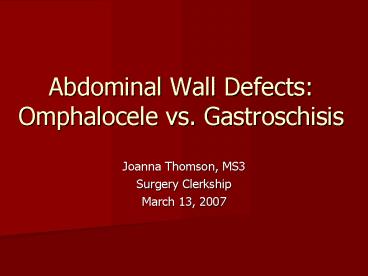Abdominal Wall Defects: Omphalocele vs' Gastroschisis
1 / 15
Title:
Abdominal Wall Defects: Omphalocele vs' Gastroschisis
Description:
As a result of rapid growth and expansion of the liver, the ... omphalocele, ectopia cordis, anterior diaphragmatic hernia, intracardiac defect, sternal cleft ... –
Number of Views:4525
Avg rating:5.0/5.0
Title: Abdominal Wall Defects: Omphalocele vs' Gastroschisis
1
Abdominal Wall DefectsOmphalocele vs.
Gastroschisis
- Joanna Thomson, MS3
- Surgery Clerkship
- March 13, 2007
2
Embryology Review
- The Midgut gives rise to
- Duodenum distal to the bile duct
- Jejunum
- Ileum
- Cecum
- Appendix
- Ascending colon
- Hepatic flexure of the colon
- Proximal two-thirds of transverse colon.
3
Week 6Physiological Umbilical Herniation
- As a result of rapid growth and expansion of the
liver, the abdominal cavity temporarily becomes
too small to contain all the intestinal loops. - The intestinal loops enter the extraembyronic
cavity within the umbilical cord during the sixth
week of development. - As herniation occurs, the loop undergoes a 90
degree counterclockwise rotation around the
superior mesenteric artery.
Source Langmans Medical Embryology. Ninth
Edition.
4
Week 10Return to Abdominal Cavity
- During 10th week of development, herniated
intestinal loops begin to return to the abdominal
cavity. - Undergoes additional 180 degree counterclockwise
rotation about the superior mesenteric artery. - Factors responsible for this return are not
precisely known... It is thought that regression
of the mesonephros (kidney), reduced growth of
the liver, and expansion of the abdominal cavity
all play roles.
Source Langmans Medical Embryology. Ninth
Edition.
5
Omphalocele
- Herniation of abdominal viscera through an
enlarged umbilical ring. - Failure of the bowel to return to the body cavity
following physiological umbilical herniation.
Defective mesodermal growth causes incomplete
central fusion and persistent herniation of the
midgut. - Extruded viscera may include LIVER, small and
large intestines, stomach, spleen, or bladder. - Covered by amnion and peritoneum
- (May rupture before or at time of delivery)
6
Source Omphalocele and Gastroschisis.
eMedicine.
7
Gastroschisis
- Herniation of intestinal loops through the
anterior abdominal wall. - Defect lateral to the umbilicus (rightgtleft)
- Abnormal involution of the right umbilical vein
or vascular accident involving the
omphalomesenteric artery causes localized
abdominal wall weakness. - No sac covers the extruded viscera.
- Having been bathed in the amniotic fluid and with
compression of the mesenteric blood supply at the
abdominal defect, the bowel wall may be inflammed
and edematous. May appear to have a thick,
shaggy membrane and loops may appear shortened
and matted together.
8
Source Omphalocele and Gastroschisis.
eMedicine.
9
Prenatal Diagnosis
- Elevated maternal serum alpha fetoprotein
- Ultrasound
- Omphalocele Gastroschisis
Source Fetal Diagnosis and Treatment. The
Childrens Hospital of Philadelphia.
10
Epidemiology
- Prevalence
- Omphalocele 1/5,000 births
- Gastroschisis 1/10,000 births
- Increasing in frequency, especially in young
women. - Mortality
- Omphalocele 25
- Related directly to presence of chromosomal and
other abnormalities - Gastroschisis lt5
Source Langmans Medical Embryology, Ninth
Edition.
11
Omphalocele Associated Anomalies
- Chromosomal abnormalities (50)
- Trisomies 13, 18, 21
- Congenital heart disease (50)
- Neural tube defects (40)
- Beckwith-Wiedemann syndrome
- LGA, hyperinsulinism, visceromegaly of kidneys,
adrenal glands and pancreas, macroglossia,
hepatorenal tumors, cloacal extrophy - Pentalogy of Cantrell
- omphalocele, ectopia cordis, anterior
diaphragmatic hernia, intracardiac defect,
sternal cleft
Source Langmans Medical Embryology, Ninth
Edition.
12
Gastroschisis Associated Anomalies
- Additional gastrointestinal problems (25)
- Including atresia, volvulus, stenosis
- Loss of bowel secondary to ischemia
- Compromised bowel function
Source Langmans Medical Embryology, Ninth
Edition.
13
Initial Management
- Acute management aimed at maintaining circulation
to bowel and preventing infection while
stabilizing infant (temperature/fluids) - Cover the defect with sterile dressing soaked in
warm saline to prevent fluid loss - Nasogastric decompression
- IV fluids with glucose
- Antibiotics
14
Surgical Treatment
- Surgery performed to return the viscera to the
abdominal cavity and close the defect. - Primary Surgical Closure Success dependent on
size of the defect and size of the abdominal and
thoracic cavities. - Staged Closure Gradual reduction of the
contents into the abdominal cavity using an
extra-abdominal extension of the peritoneal
cavity (termed a silo) and using gentle pressure.
Usually requires 1-3 weeks, after which the
defect is then primarily closed.
15
Source Omphalocele and Gastroschisis.
eMedicine.































